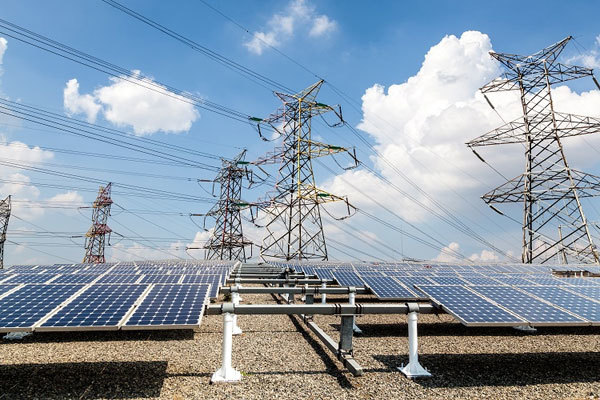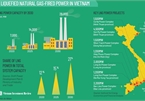However, after the publication of the plan’s third draft, several local institutions have criticised the set focus and have warned about entailing risks.
 |
| PDP8 priorities and risks addressed. Illustration photo |
The third draft of the National Power Development Plan 8 (PDP8) for the 2021-2030 period, with a vision to 2045, developed by the Ministry of Industry and Trade is the result of the third consultation of ministries, sectors, and businesses operating in the sector.
According to the most recent calculations, the forecast commercial electricity mentioned in the PDP8 will be lower than the adjusted PDP7, by about 15 billion kilowatt-hours by 2030. As another new element, the electricity demand will shift from the south to the north.
The new plan will give priority to the exploitation of renewable energy sources for electricity generation. However, due to the exhaustion of natural gas resources, as well as the uncertainties linked to the exploitation of new gas fields, Vietnam will have to import liquefied natural gas (LNG) on a large scale to supply LNG-fired power plants and ensure energy security.
Along with that, the development of gas-related infrastructures such as warehouse and port systems are necessary.
Besides imported gas, it may be also necessary to promote the import of coal in large volumes to ensure a stable fuel supply for the current and planned coal-fired thermal power plants.
Nevertheless, there is a much stronger focus on exploiting renewable energy sources than before, especially offshore wind, solar, and biomass power sources, along with other renewables. The selected scheme satisfies the power supply and international commitments to reduce environmental pollution in the generation process with low production costs and harmonising benefits for the state, investors, and end-users.
Moreover, the PDP8 meets the criteria set out in Politburo’s Resolution No.55/NQ-TW on the orientation of the National Energy Development Strategy of Vietnam to 2030, with a vision to 2045.
The PDP8 can give high priority to the development of renewable energy sources and promoting the development of projects for LNG power and the gradual reduction of coal-fired plants.
The plan is currently divided into six major areas and 19 sub-regions to analyse and build a strong transmission grid between the regions. Before 2030, all mentioned regions are planned to be linked by many 500kV lines. After 2030, there will be more one-way power transmission lines to release the capacity of clusters of large offshore wind power sources to the central units.
The scheme needs about $128.3 billion, of which about $95.4 billion are reserved for power sources and the remaining $32.9 billion for the grid. In the 15 years after that, another $192.3 billion will be required to be split into $140.2 billion for power generation and $52.1 billion for the transmission network.
Furthermore, the plan proposes three groups of mechanisms for its implementation, including investments in electricity development, capital attraction and mobilisation, and for ensuring the electricity system’s operation under market conditions, including the integration of renewable energy sources.
In addition, 13 solutions related to the revision of legal documents, capital solutions, electricity prices, environmental protection, science and technology, human resources development, and organisation are also mentioned in this scheme.
Important source
Deputy Prime Minister Trinh Dinh Dung, who is also part of the National Power Development Plan Appraisal Council said, “In this master plan, solar and wind energy sources should continue to be prioritised for development as they are both natural resources that are especially abundant in Vietnam. However, it is necessary to form and maintain a stable supply for the whole system.”
The deputy PM noted that the development of renewable energies should consider power reserves while ensuring operational safety for the whole system and source capacities.
According to the PDP8, the coal power structure will be decreasing in total capacity. However, this is currently a particularly important source of energy and serves as the backup for the entire system. Regarding the implementation of the plan, Deputy PM Dung said that appropriately allocated capital sources should be considered, including the list of projects that can be exploited soon.
He also believed the PDP8 will create an important innovation step and serve as the foundation for mobilising resources for the development of the power industry, thereby meeting the socioeconomic needs of the nation.
Coal power still preferred
The draft shows a gradual decrease in coal power development and a gradual increase in renewable energy development, separated into phases.
However in the next decade, coal-fired power will still have a high priority due to the addition of about 17GW of new coal power plants to the system.
The Vietnam Sustainable Energy Alliance, the Vietnam Non-Communicable Disease Prevention Alliance, and the Vietnam Rivers Network have recommended considering the suitability, feasibility, and consequences of the new coal power development plan in five aspects.
Firstly, without learning from the implementation of the PDP7, shortcomings will continue to exist, leading to risks of further delays of coal power projects. Their development between 2016 and 2020 faced many difficulties in both capital mobilisation and lack of support from residents and local authorities, resulting in a mere 57.6-per-cent fulfilment of the PDP7. In the past five years, only about 7GW of coal power plants were put into operation, of which only one unit (0.6 GW) was put into operation by 2020.
Secondly, there is a strong dependence on external supplies as 86 per cent of new coal plants must use imported material, while the ability to import from the sources identified in the draft forecasts face many difficulties, possibly affecting national energy security.
Thirdly, new high-tech coal-fired power plants do solve the environmental problem, and at the same time make it more expensive than developing renewable energy sources.
Also, continuing to develop new coal power projects will guide Vietnam in the opposite direction of the global world and contradicts the efforts to implement the climate goals of the Paris Agreement. To achieve this goal, it is necessary to close all coal power plants globally by 2040. However, the plants in the current draft are meant to operate at least until 2050, possibly even until 2070.
Lastly, according to the scenario in the current draft of the master plan, the total amount of greenhouse gas emissions will increase continuously from 9,500 tonnes last year to over 42,000 tonnes by around 2035, which poses a high risk of further air pollution and impacts the environment and public health.
The reports by the three agencies added that the total capacity of renewable energies that is meant to be mobilised is very low compared to the potential and makes up only about 4-5 per cent by 2030, and 13-16 per cent by 2045. Some renewable options that have the advantage of decreasing costs and offering effective solutions may not be sufficiently mobilised within the next 10 years.
According to the draft, solar power takes a minor role with only about 2GW put into operation. Moreover, solar power in combination with agriculture has not been considered and there is no mechanism to encourage this development. Meanwhile, offshore wind power, hydropower, and battery storage for these systems have not been included in this period.
VIR

Vietnam needs to enhance energy efficiency methods
Ngo Thuy Quynh, deputy director of Petroleum and Coal Department under Ministry of Industry and Trade spoke about the master plan for development of Vietnam's petroleum industry.

Full steam ahead for LNG capacities to omit fossil fuels
With its rapid development, Vietnam’s hunger for reliable and sustainable energy sources grows daily.